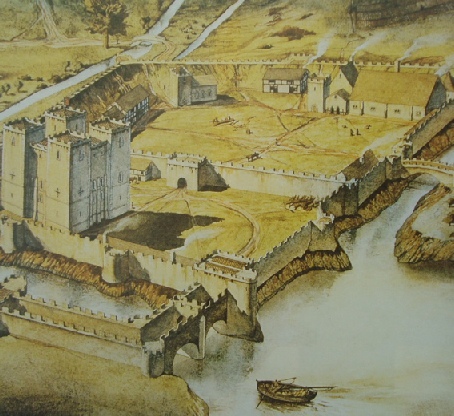 Bristol the cleeve frenchay the river frome at the top of the hill
Bristol the cleeve frenchay the river frome at the top of the hill
There is very little left of Bristol Castle, but at one time it was one of the largest Norman Keeps in the country.
It was important enough to be used in the city's coat of arms, which depicts a ship leaving the protection of the Water Gate. The story of the castle is the story of Bristol at the time. For this reason some of the material here is drawn from other parts of my site.Bristol's Arms Bristol was founded sometime between 577 and 978 AD, nestled between the Rivers Frome and Avon, the waterways provided Bristol with near perfect protection. The building of a wall around the town further increased its fortifications.
It will become obvious why the castle was built, maintained and eventually demolished. This was not the time 'Merrie Olde Englande' -
The Lords built the Castles and the Churches. They more or less had the priests in their pockets and between them the commoners were told what to do and how to act. Although laws were in existence, peoples day to day living was still dominated by tradition and custom.
Not only that, but practically everyone seemed to be want to be king. As one Lord fell out of favour then you can bet someone else was looking longingly at their possessions. This in turn to led to fighting which would involve whole towns and villages. To give an example, between the Norman Conquest of 1066 and the Black Death of 1348, England enjoyed only one period of domestic peace that lasted more than 30 years.
Bristol ~ before 1000 AD (the area enclosed by the Old City Walls)
The named streets are still in existence.
Beginnings -
Anglo-
About the time of the Norman conquest (1066), the Manor of Barton, in which Bristol was situated, had to pay the Governor £28 and the King £73.35 in taxes. This was in the days when money was worth many, many times what it is today. To give an idea of how much this was only four other towns, London, York, Lincoln and Norwich paid more. Although only in existence for a couple of hundred years at the most, Bristol was already a prosperous town.
In 1051, Bristol was part of the Earldom of Swegen. Swegen was the eldest son of Earl Godwin. Later that year Godwin, Swegen and his brother, Harold were exiled and went to live in Ireland. In 1068 three sons of Harold (and their followers) tried to take the city by force but were repulsed.
It became apparent that what Bristol needed was a stronger defense. Although Bristol had offered no resistance to William the Conquerer, he probably thought that a castle might also overawe the locals and secure their allegiance. Geoffrey Mowbray or Geoffrey de Montbray, Bishop of Coutances was put in charge of the work. Mowbray has been described as an unpriestlike Bishop, more accustomed to the mace and sword than the mass-
The castle was built on what is now known as Castle Green (see map above) east of the town, protecting the town from the only direction not surrounded by the rivers. The first stone walls of the town, which probably followed the old Anglo-
William I (William the Conquerer) died in 1088, and his decond son William Rufus became king of England as William II. His eldest son, Robert Curthose only inherited Normandy. Many people thought this was unjust, including Geoffrey Mowbray. Mowbray marched out of Bristol Castle, burned Bath, then rampaged through Somerset and Wiltshire. The revolt soon collapsed. Mowbray made peace with William II and was lucky enough to escape any punishment. Geoffrey died in 1093 and the castle was handed over to Robert FitzHamon. (Geoffrey de Montbray)
Robert Fitzhamon and Robert of Caen
In 1106 FitzHamon built St. Peter's church. Although the Castle was demolished in 1665, on the orders of Oliver Cromwell, the remains of St. Peter's are still on Castle Green. It managed to survive more than 800 years, up until Sunday, 24th November 1940 when it was hit by a bomb during the Second World War. All that remains now is the tower and exterior walls.
St. Peter's church ~ built 1106, destroyed 24th November 1940
The photo was taken from a balloon, July 1999
FitzHamon died from wounds received whilst fighting for King Henry I against Robert, Duke of Normandy. His daughter, Mabel, was married off to Henry I's illegitimate son, Robert of Caen who was made the Earl of Gloucester. He greatly enhanced the castles defenses and using stone from Caen, France, built a Keep for the castle. Caen stone or Pierre de Caen, is a light creamy-
The castle itself, with 7 great towers, was divided into two parts, an Inner Ward and an outer Ward surround by a moat. Outside this was the town surrounded by the new wall. At the furthest end of the Outer Ward facing east was the entrance known as the Lawfords Gate. There must have been an additional gate entrance that connected the castle Wards to the town.
The outer ward contained the Keep, Constables Lodgings and St. Martin's Chapel. Within the Inner Ward, the part nearest Old Market to the east of the outer ward, was the Royal Chapel, banquet hall and Prince's Chambers. William Wyrcester measured the banquet hall in the fifteenth century and found it to be 108ft. by 54ft. The walls were 24ft high with 14ft. high windows. Two rows of 43ft high wooden pillars ran the length of the hall supporting the roof. The hall contained a 15ft. long marble table. The outer Ward also contained the great well and the dungeons, as well as apartments for the garrison.
He also extended the town walls to enclose a larger area, southwards over the 'marsh' and built the new town wall south of the River Avon between Redcliffe Backs and Temple Meads. In all nine new town gates were constructed Temple and Redcliffe in the new south wall, Marsh, Back Street, and Marsh Street in the Marsh section of wall, Frome leading out over Frome bridge, plus Aylward (later nether Pithay) and Newgate facing the river Frome to the north. (an additional gate Needless, was added in around 1630 just to the northwest of Aylward Gate) From the castle ward a gate entrance to the east over the moat connecting the river Frome to the Avon was built, Castle Gate. This was demolished 1766. The gate between the castle ward and the town to the west could have been that referred to as Queen Street Gate and was demolished 1762. A chronicler of that time states 'that the town was almost the richest in the country owing to its foreign and domestic trade, while its castle, standing on a mighty mound was garrisoned by crowds of knights and soldiers'.
Robert of Caen also built St. Ewen's church at the corner of Broad and Corn streets. This building still stands, only now it is known as 'Christchurch, incorporating St. Ewen's and St. George'. Robert of Caen aka the Earl of Gloucester aka Robert of Gloucester died in 1147.
Christchurch from the corner of Castle Green
The magnificently carved entrance to Christchurch
The clock of Christchurch -
This clock still works, and on the hour the men tap the bells with the hammers.
Matilda, Maud and Stephen
King Henry I, who ruled from 1100 to 1135, made his Barons promise that his daughter, Matilda, also known as Maud -
David I of Scotland, Maud's uncle, tried to come to her aid, but was defeated in 1138. The same year Stephen decided to reduce the power of Robert of Gloucester (he who had made Bristol Castle one of the strongest in the country) who was half brother to Maud. Robert of Gloucester was in Normandy at the time but immediately sided with Maud and sent a message of defiance to Stephen.
Stephen then seized all of Robert's property, with the exception of Bristol, which proved too strong for him. Bristol gathered together an army of mercenaries and these laid waste to most of the surrounding areas. The time was known as the "Bristol War". Many people captured by raiding parties from Bristol, if they were rich they were ransomed, if not, they were sold as slaves -
Stephen besieged the city but gave up as he couldn't take it -
FitzHarding was their loyal friend and supporter to Matilda and Henry, placing his wealth derived from owning a number of manors in Gloucestershire, at their disposal. FitzHarding went on to purchase from Earl Robert, the manor of Billeswick which lay just outside the town walls to the south west. It was here that he founded the abbey of Augustinian Canons, the church of which, after the Dissolution, became the cathedral church of Bristol. It's foundations were started in 1140 and was ready for its dedication in 1146.
In 1141 Stephen was defeated at Lincoln and Matilda or if you prefer, Maud had him brought in chains to Bristol as a prisoner. Maud became Queen. Stephen was kept in the castle for eight months but in the autumn of the same year Robert himself was captured and an exchange of prisoners was arranged. By now England was in a right old mess. There had been wars between the rival factions for the monarchy and between the Barons for more than six years. The fields had been left untended and people were dying from starvation. In 1147, Robert, died aged 57 in Bristol Castle. Maud was defeated at Oxford and realising the game was up, left the country, Stephen became King of England.
In 1153, Eustace, Stephen's son died. At the Treaty of Wallingford, Stephen agreed with Henry of Anjou, Maud's son, that on his death that the Crown should pass to him. Stephen died just a year later and Henry of Anjou became Henry II of England. He never forgot the protection that Bristol had given him and in 1155 he granted a Charter to the people of Bristol, this Charter freed them from all tolls and affirmed their rights as freemen. Anyone trying to levy tolls on the people of Bristol were to be given the hefty fine of £10.
In 1188 Henry II reaffirmed the rights of the people of Bristol. They were allowed local Courts, thus no longer had to travel to Gloucester, a days travel at that time. The right to freedom from tolls was reaffirmed and so were no longer obliged to grind corn at the lord's mill. Bristolians were allowed to marry without the permission of their lords. On the trading front, the citizens could buy imported goods within the town, whilst the rights of 'strangers' and 'foreigners' to sell goods within the town was restricted
